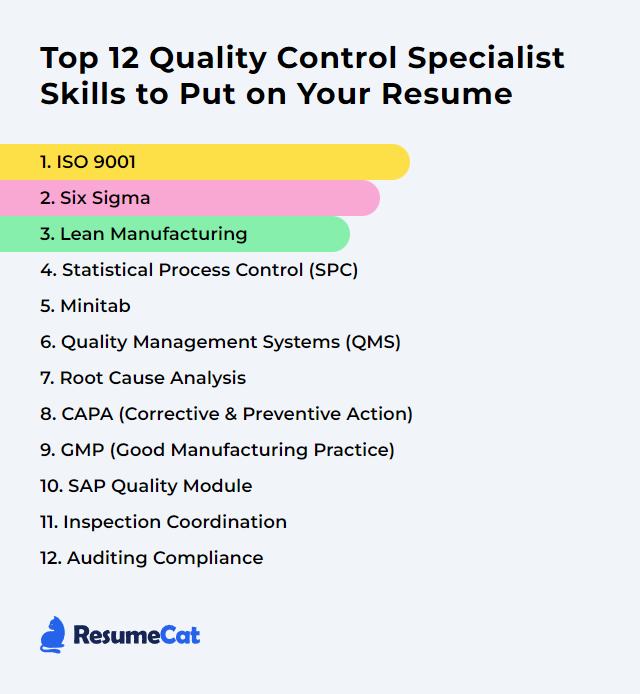Top 12 Quality Control Specialist Skills to Put on Your Resume
In today's crowded job market, a Quality Control Specialist needs a resume that doesn’t just list duties but signals judgment, rigor, and calm under pressure. Showcasing the right mix of technical depth and people skills helps you get noticed and hired—so you can keep products safe, consistent, and compliant.
Quality Control Specialist Skills
- ISO 9001
- Six Sigma
- Lean Manufacturing
- Statistical Process Control (SPC)
- Minitab
- Quality Management Systems (QMS)
- Root Cause Analysis
- CAPA (Corrective and Preventive Action)
- GMP (Good Manufacturing Practice)
- SAP Quality Module
- Inspection Coordination
- Auditing Compliance
1. ISO 9001
ISO 9001 sets the bar for quality management systems, laying out a framework to consistently meet customer and regulatory requirements while driving continual improvement.
Why It's Important
It anchors your system. Processes become predictable, risks get managed, and customers feel the difference. For a Quality Control Specialist, it’s the backbone that aligns procedures, data, and decisions.
How to Improve ISO 9001 Skills
Engage Leadership: Ensure management shows visible commitment and resources to the QMS in line with ISO 9001:2015 leadership expectations.
Risk-Based Thinking: Bake risk and opportunity planning into objectives, changes, and controls (ISO 9001:2015 planning principles).
Continuous Improvement: Use PDCA cycles, structured problem solving, and quality tools to chip away at variation month after month.
Competence and Awareness: Train roles against current procedures and verify competence. Make responsibilities unmistakably clear.
Customer Focus: Capture and analyze customer feedback; feed it into management reviews and corrective actions (performance evaluation per ISO 9001:2015).
Internal Audits: Run risk-based audits using recognized auditing practices (e.g., ISO 19011 guidance) to uncover gaps early.
Documented Information: Control procedures, records, and revisions per ISO 9000/9001 principles. Keep it lean, current, and traceable.
Supplier Control: Qualify, monitor, and improve external providers under clear criteria for quality and delivery (operational control requirements).
Work these levers consistently and your QMS tightens up—fewer surprises, better outcomes, stronger certification posture.
How to Display ISO 9001 Skills on Your Resume
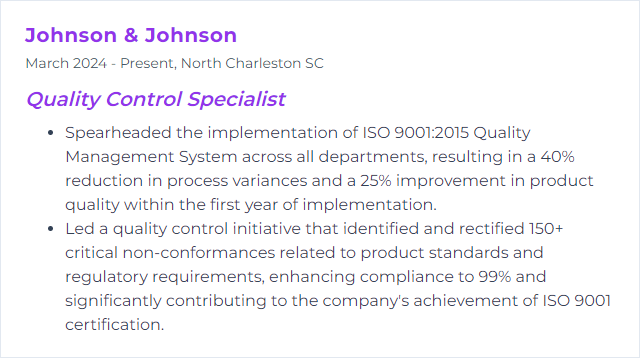
2. Six Sigma
Six Sigma is a data-first method to reduce defects and process variation so outputs land inside spec—reliably.
Why It's Important
It gives you a disciplined toolkit for measurable gains: clearer baselines, sharper root causes, and control plans that stick. Efficiency rises, rework drops.
How to Improve Six Sigma Skills
Level Up Certifications: Pursue Green Belt and Black Belt training; keep practicing DMAIC and DMADV with real projects.
Deepen Analytics: Strengthen statistical chops—capability analysis, hypothesis testing, DOE—using software like Minitab.
Choose the Right Projects: Tie efforts to business KPIs with clear CTQs, baselines, and financial impact.
Cross-Functional Muscle: Pull in production, maintenance, supply chain, and quality early. Diverse voices spot blind spots.
Kaizen Mindset: Blend Lean and Six Sigma—remove waste while reducing variation for compound gains.
Benchmark: Compare process maturity and metrics against industry peers to set ambitious, realistic targets.
Do the fundamentals well, then scale. Results will snowball.
How to Display Six Sigma Skills on Your Resume
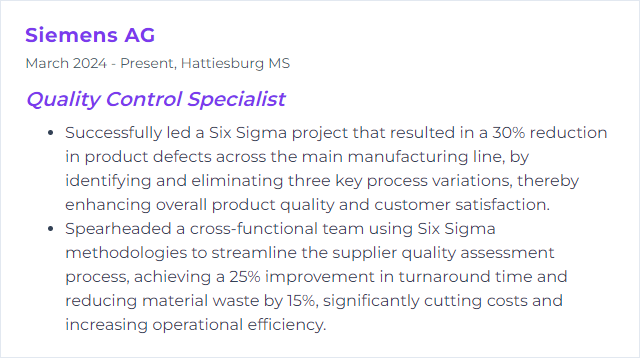
3. Lean Manufacturing
Lean Manufacturing cuts waste, shortens cycles, and elevates flow. For quality, that means fewer defects, tighter processes, and smoother handoffs.
Why It's Important
Less clutter, clearer standards. When processes run cleanly, quality stabilizes and customers feel the steadiness.
How to Improve Lean Manufacturing Skills
Kaizen in the Daily Work: Make small improvements habitual—visual boards, quick wins, team huddles.
Poka‑Yoke: Error-proof where you can—fixtures, sensors, design constraints that make mistakes hard to make and easy to catch.
5S Discipline: Sort, set in order, shine, standardize, sustain. Order drives speed and quality together.
Standard Work: Document the current best method with cycle times and key points; audit it; improve it.
Jidoka: Build in stop-the-line authority and automated detection to prevent defects from flowing downstream.
Root Cause Tools: Use 5 Whys, fishbone diagrams, and Pareto to focus energy where it matters.
Lean Six Sigma: Combine value-stream mapping with statistical control to attack waste and variation together.
Upskill the Team: Train operators and techs to see waste, measure it, and kill it. Empowerment beats top-down memos.
Lean sticks when it lives in the habits, not just the posters.
How to Display Lean Manufacturing Skills on Your Resume
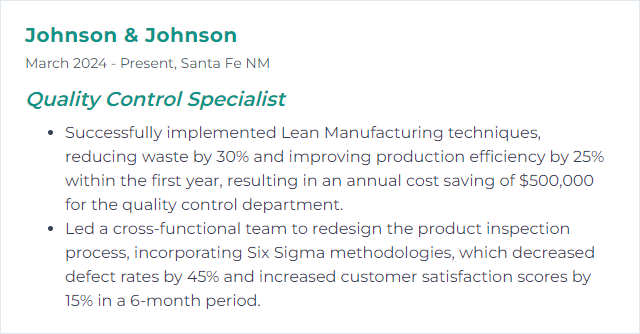
4. Statistical Process Control (SPC)
SPC uses statistical signals to keep processes stable and capable, catching shifts before customers do.
Why It's Important
It lowers variability, trims scrap, and preserves capacity. With good charts and good discipline, you keep output on the rails.
How to Improve Statistical Process Control (SPC) Skills
Teach the Fundamentals: Control charts, special vs. common cause, subgrouping, sampling plans—make them second nature across shifts.
Right‑Fit Software: Select SPC tools that support real-time data, alarms, and easy dashboards for operators.
Clean Data In: Automate collection where possible; standardize measurement methods and calibration routines.
Refresher Cadence: Run short, frequent training and chart reviews to keep interpretation sharp.
Improve Culture: Reward early detection and honest signaling. Don’t punish red flags—fix them.
Audit the System: Periodically review chart selection, sampling frequency, and reaction plans for relevance.
Tailor the Toolbox: Use the right chart (X‑bar/R, I‑MR, p, u) and supplement with capability studies and DOE when needed.
Act on Signals: Define clear out-of-control action plans so responses are fast, consistent, and verified.
SPC only works if people trust the data and act on it. Build both.
How to Display Statistical Process Control (SPC) Skills on Your Resume
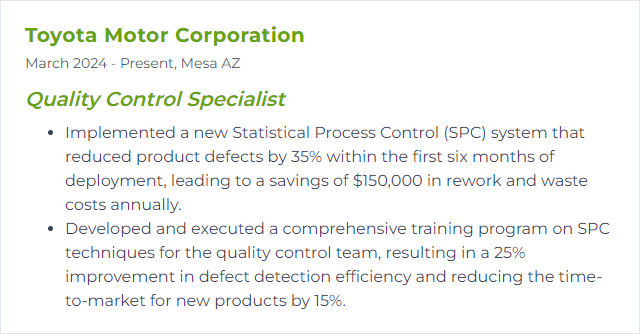
5. Minitab
Minitab is a workhorse for quality analytics—capability, control charts, regression, DOE, and clean visuals that persuade.
Why It's Important
It shortens the path from raw data to insight. With better analysis, you find true causes faster and lock in improvements.
How to Improve Minitab Skills
Strengthen Statistics: Shore up probability, inference, SPC, and experimental design through structured courses and practice.
Use Official Tutorials: Work through Minitab’s guided resources and sample datasets to master the features you actually need.
Take Focused Courses: Pick classes on quality engineering with Minitab from reputable training providers.
Practice on Real Data: Analyze shop-floor datasets, supplier performance, and complaint trends; build a portfolio.
Join the Community: Ask and answer questions in user forums; borrow templates and macros that save time.
Seek Feedback: Have peers review your analyses and assumptions; iterate to improve clarity and rigor.
Proficiency grows fastest when you learn, apply, and review in quick cycles.
How to Display Minitab Skills on Your Resume

6. Quality Management Systems (QMS)
A QMS is the scaffolding of policies, processes, and records that ensures consistent quality and continual improvement.
Why It's Important
It standardizes how work gets done, reduces ambiguity, and keeps the organization aligned with customers and regulators.
How to Improve Quality Management Systems (QMS) Skills
Assess the Current State: Map processes, KPIs, and pain points; prioritize changes that reduce risk and waste.
Involve Stakeholders: Pull in operators, engineers, suppliers, and customers to shape practical, accepted procedures.
Build a CI Engine: Embed Kaizen and structured problem solving; review progress in management reviews.
Train for Competence: Align training to procedures and standards; verify effectiveness, not just attendance.
Adopt Enabling Tech: Use QMS software for change control, document management, CAPA, and audit trails.
Audit Regularly: Internal and external audits should be risk-based and feed corrective actions with owners and due dates.
Benchmark: Compare your QMS maturity with peers and standards; import better practices thoughtfully.
Manage Risk: Apply ISO 31000 principles to identify, evaluate, and treat risks across processes and suppliers.
Keep it simple. Keep it current. Make it useful and people will use it.
How to Display Quality Management Systems (QMS) Skills on Your Resume
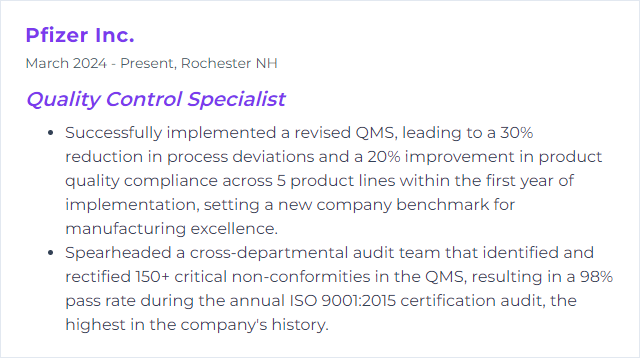
7. Root Cause Analysis
Root Cause Analysis (RCA) is the disciplined hunt for the underlying causes of problems so they don’t come back.
Why It's Important
Fixing symptoms is fast but fleeting. RCA targets the source, saving time and money while protecting customers.
How to Improve Root Cause Analysis Skills
Define the Problem Precisely: Scope it with clear what/where/when/how big. Ambiguity derails the effort.
Gather the Evidence: Collect data, timelines, photos, and process details; separate facts from assumptions.
Generate Causes: Use fishbone diagrams, 5 Whys, and process maps to surface plausible contributors.
Verify the Root(s): Test hypotheses with data, experiments, or controlled trials; use Pareto and FMEA to prioritize.
Implement Corrective and Preventive Actions: Assign owners, deadlines, and measures of effectiveness; make changes stick.
Monitor Results: Track leading and lagging indicators; adjust if residual effects linger.
Document and Share: Capture the story, lessons, and updated standards so future teams start smarter.
Good RCA is calm, curious, and relentless—never accusatory.
How to Display Root Cause Analysis Skills on Your Resume
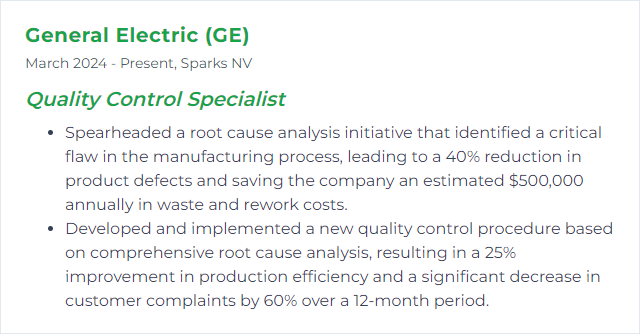
8. CAPA (Corrective and Preventive Action)
CAPA is the structured system to fix nonconformities and prevent them from returning—documentation included.
Why It's Important
It closes the loop. Evidence-based fixes, verified outcomes, and audit-ready records build trust and compliance.
How to Improve CAPA (Corrective and Preventive Action) Skills
Clarify the Issue: Define the deviation and its impact; link to data and requirements.
Risk First: Use FMEA or similar methods to prioritize actions by severity, occurrence, and detectability.
Target Root Causes: Tie actions directly to verified causes—not just surface fixes.
Make Actions SMART: Specific, measurable, achievable, relevant, time-bound—with clear owners and resources.
Train and Communicate: Update procedures and train affected teams; make changes visible and understood.
Effectiveness Checks: Define how you’ll confirm success (metrics, audits, stability over time).
Document Thoroughly: Maintain traceable records from issue to verification in line with ISO 9001 principles.
Evolve the System: Review CAPA cycle times, backlog, and repeat issues; improve workflows and criteria.
For regulated devices, align with current international guidance (e.g., IMDRF) and plan for FDA’s Quality Management System Regulation (QMSR) alignment with ISO 13485.
How to Display CAPA (Corrective and Preventive Action) Skills on Your Resume
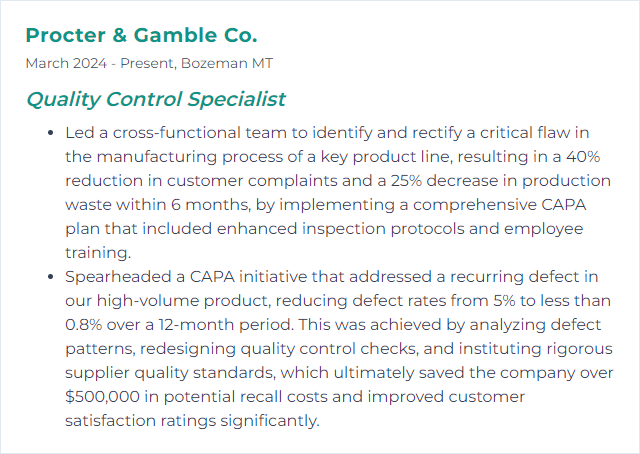
9. GMP (Good Manufacturing Practice)
GMP is the rulebook for consistent, controlled manufacturing. It guards safety, identity, strength, quality, and purity.
Why It's Important
Testing alone can’t catch everything. Sound GMP prevents issues at the source and proves control to regulators.
How to Improve GMP (Good Manufacturing Practice) Skills
Stay Current: Review applicable GMP regulations and guidance routinely; update SOPs and training accordingly.
Train with Intention: Offer role-specific, scenario-based training and verify understanding, not just completion.
Audit with Purpose: Run internal audits and supplier audits on a risk-based schedule; track findings to closure.
Documentation that Works: Maintain accurate, contemporaneous, attributable records; follow ISO 9001/ISO 13485 documented information requirements and ISO 10013 guidance for structure.
Strengthen QC Testing: Upgrade methods and equipment where needed; trend data to see shifts early.
Continuous Improvement: Apply Kaizen or Six Sigma to reduce deviations and batch failures over time.
Close the Feedback Loop: Feed audit findings, complaints, and deviations into CAPA and change control.
Discipline, traceability, and culture make GMP real—every shift, every batch.
How to Display GMP (Good Manufacturing Practice) Skills on Your Resume

10. SAP Quality Module
SAP Quality Management (QM) integrates quality planning, inspections, notifications, and certificates across the enterprise—often alongside MM, PP, and SD.
Why It's Important
It centralizes data and workflows, reduces manual touches, and gives end-to-end visibility from supplier to shipment.
How to Improve SAP Quality Module Skills
Streamline Processes: Configure QM to mirror real workflows; eliminate duplicate entry and unclear statuses.
Strengthen Master Data: Define clear rules for materials, specs, and inspection plans; govern changes tightly.
Integrate Deeply: Connect QM with MM/PP for automatic triggers and results recording at the right steps.
Use Analytics: Build dashboards and reports to trend defects, DPPM, and cycle times; act on the signals.
Train the Users: Provide role-based training and quick-reference guides; gather feedback to refine screens and steps.
Continuous Enhancement: Maintain a backlog of improvements; review periodically with power users and IT.
Good configuration plus good data equals trustworthy quality decisions.
How to Display SAP Quality Module Skills on Your Resume
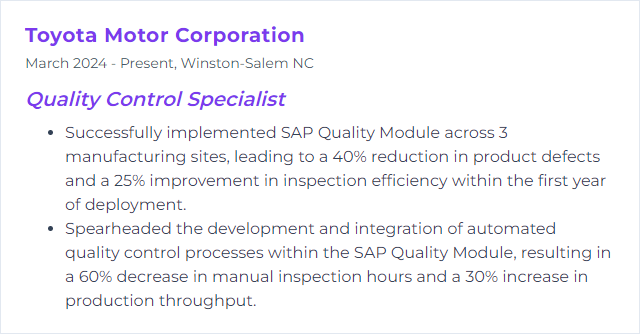
11. Inspection Coordination
Inspection coordination means planning, scheduling, and steering inspections so products and processes meet requirements without chaos.
Why It's Important
It synchronizes teams, reveals defects early, and keeps compliance airtight. Missed inspections hurt; well-run ones prevent headaches.
How to Improve Inspection Coordination Skills
Unify Communication: Use centralized channels (for example, Slack or Microsoft Teams) and clear handoff rules.
Plan the Work: Employ project/task tools like Trello or Asana to assign owners, due dates, and priorities.
Standardize Checklists: Create version-controlled, role-ready checklists stored in shared drives (e.g., Google Drive, Dropbox).
Leverage QMS: Integrate inspection plans, records, and nonconformances in your QMS for traceability.
Train Continuously: Keep inspectors sharp on sampling, measurement techniques, and acceptance criteria.
Close Feedback Loops: Review inspection outcomes with production and engineering; refine criteria and methods.
Coordination is logistics plus clarity—done right, everything moves on time.
How to Display Inspection Coordination Skills on Your Resume
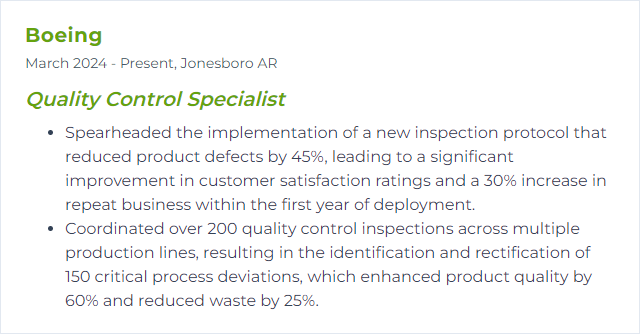
12. Auditing Compliance
Auditing compliance is the structured evaluation of processes and records against internal standards and external regulations.
Why It's Important
It validates that what’s written is what’s done—and that what’s done actually works. The result: fewer surprises, stronger certification results, safer products.
How to Improve Auditing Compliance Skills
Educate the Organization: Train auditors and auditees on requirements, audit etiquette, and evidence expectations.
Document with Rigor: Keep records complete, legible, and traceable; manage changes with version control.
Run Regular Internal Audits: Use risk-based plans and objective checklists; follow findings to verified closure.
Drive Continuous Improvement: Turn audit trends into CAPAs and process updates; watch for repeat findings.
Use the Right Tools: Adopt systems for audit scheduling, workflows, and dashboards to improve visibility.
Build a Compliance Culture: Recognize teams that surface issues early and fix them—compliance as a daily habit.
Audits shouldn’t be feared. They’re flashlights, not hammers.
How to Display Auditing Compliance Skills on Your Resume

